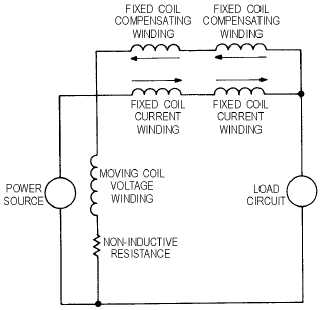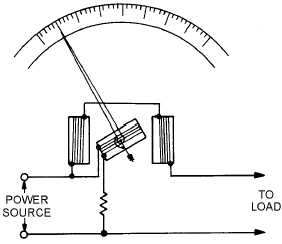3-14
Figure 3-11.—Electrical equivalent of the compensated electrodynamic wattmeter.
Electrodynamic wattmeters are subject to errors arising from various factors, such as temperature
and frequency characteristics and vibration. Heat through the control mechanism can cause the springs to
lengthen and lose tension; as a result, deflection errors are produced. Figure 3-12 illustrates the
mechanical equivalent of the electrodynamic wattmeter. Large currents within the circuit will also
produce errors. Therefore, the maximum current range of electrodynamic wattmeters is normally
restricted to about 20 amperes. When larger load currents are involved, a current transformer of suitable
range is used in conjunction with the wattmeter. However, a current transformer cannot be used if the ac
circuit under test contains a dc component.
Figure 3-12.—Mechanical equivalent of the electrodynamic wattmeter.
The voltage range of wattmeters is generally limited to several hundred volts because of heat
dissipation within the voltage circuit. However, the voltage range can be extended by using external
voltage dividers. Wattmeters used as laboratory standards have an accuracy of 0.1%, high-grade portable
wattmeters an accuracy of 0.2% to 0.25%, and high-grade switchboard wattmeters an accuracy of 1% of




